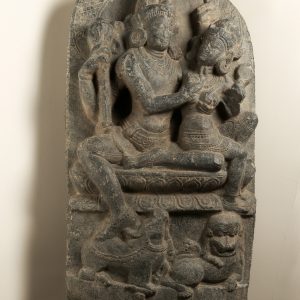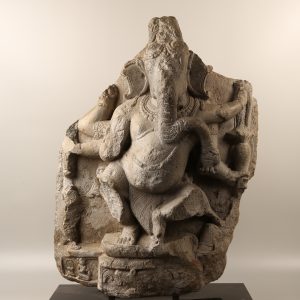Śiva Naṭarāja
48 000,00€
Red sandstone
Northern India
Circa 11th Century, Pratīhāra period
H. 63 cm or 24 ⅞ in
Description
Beautiful stele of Śiva Naṭarāja in the chatura-tāṇḍava pose. It is the 107th step in the 108 step dance of Śiva Naṭarāja, just before he launches into destruction. Śiva as Naṭarāja is the cosmic dancer and is the master and source of all the dance forms and performs the tāṇḍava, the dance in which the universe is created, maintained, and dissolved. The chatura tāṇḍava pose is that where the right leg is firmly placed on the apasmārapuruṣa (ignorance) and the left leg is raised half way into the air shortly before being stretched out as the Naṭarāja tāṇḍava pose.
Śiva’s hair is dressed high in jaṭāmukuṭa and his long, matted tresses, usually piled up in a knot, loosen during the dance and crash into the heavenly bodies, knocking them off course or destroying them utterly. A thin sash runs around the waist. The costume consists of short drawers worn with an elaborate girdle decorated with a floral clasp in front. He wears a tiara with fillet, several ear-rings and a chain of flowers on each shoulder, yajñopavīta, necklace, udarabandha, spiral armlets, bracelets, rings and anklets. The stoic face of Śiva represents his neutrality, thus being in balance and is surrounded by flames which represent the manifest Universe.
Śiva’s upper right hand holds a small drum shaped like an hourglass (reṇugarbha). A specific hand gesture (mudra) called çlamaru-hasta is used to hold the drum. It symbolizes sound originating creation or the beat of the drum is the passage of time. His lower left hand holds a sword which signifies that he is the destroyer of births and deaths and his mid left hand holds a akṣamālā (rosary) made of rudrākṣa beads which symbolizes concentration. Rudrākṣa mālā have been used by Hindus and Buddhists as rosaries at least from the 10th century for meditation purposes and to sanctify the mind, body and soul.
Śiva’s mid left hand is in abhaya mudra (fearlessness gesture) with a serpent coiled around the forearm, the abhaya mudra is meant to bestow protection from both evil and ignorance to those who follow the righteousness of dharma. His other mid left hand holds a kāpala daṇḍa (skull-club) that derives from the khaṭvaṅga (long skull-capped staff originally created to be used as a weapon). Most of the Śiva temples in south India have a separate shrine for Naṭarāja inside their temple premises. A separate hall called Nāṭa mandapam is present next to the Naṭarāja shrine for the dance presentations.
Provenance: Private collection, United-Kingdom.
Art Loss Register Certificate, ref. S00090120.
- Rao, T.A. Gopinatha, Elements of Hindu Iconography, Vol. II, Part-I, Indological Book House, Varanasi, 1971, p. 223-231
- Govindarajan Hema, The Nataraja Image from Asanpat, in Dimension of Indian Art, I, 1986
- Lord Shiva Nataraja : The Cosmic Dancer, OHRJ, Vol. XLVII, No. 3, p. 94-100









